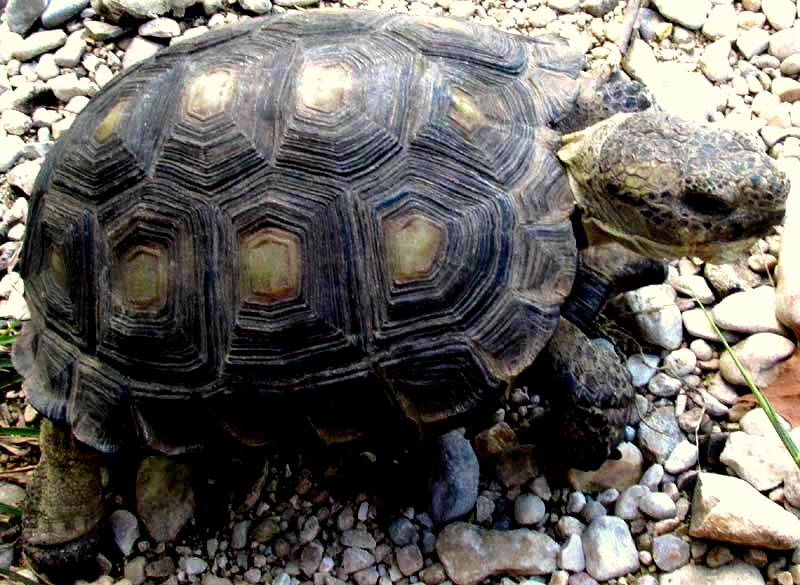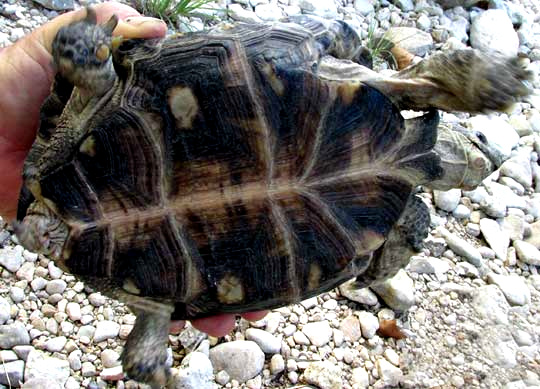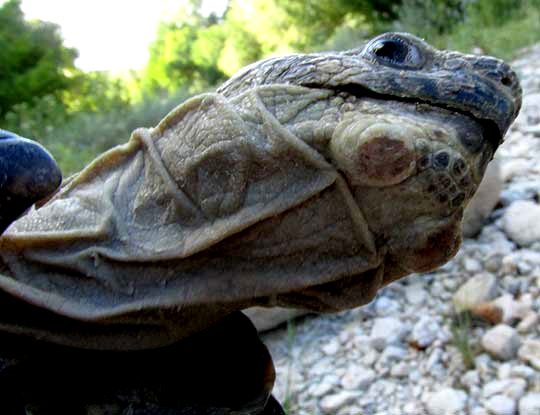Excerpts from Jim Conrad's
Naturalist Newsletter

from the September 21, 2014 Newsletter issued from the Frio Canyon Nature Education Center in the valley of the Dry Frio River in northern Uvalde County, southwestern Texas, on the southern border of the Edwards Plateau; elevation ~1750m (~5750 ft); N29.62°, W99.86°; USA
TEXAS TORTOISE
On a stretch of white limestone gravel a dark, cobblestone-size item was roaming about this way and that, as if confused or in such a tizzy that a definite route just couldn't be decided on. When I got close enough to see that it was a high-domed turtle -- more correctly a tortoise -- instead of running from me the critter headed my way. I stood still while the wanderer approached my feet, stopped, looked about, and circled my feet as if expecting something of them. Above you can see the tortoise orbiting my feet.
With such a high top shell, or carapace, and being on dry land, your first impression might be that this is a box turtle, though most box turtles carapaces display pale, often yellow, streaks. But, notice those back legs, like elephant legs, thick and roundish in cross section. And if that doesn't convince you that you have something other than a box turtle, delicately lift the turtle and take a look at the bottom shell, the plastron, as shown below:

Beneath the neck, notice how an extension of the plastron projects forward well beyond the rest of the shell. This projection is called the "gular scute" or "gular projection." No box turtle plastron is anything like this. Also, box turtle plastrons are hinged more or less between the two front legs, so the front can be "drawn up" when the turtle pulls his head in, but there's no hint of a hinge here. And, while we're looking at things from below, note those two, pea-sized bulges on the lower jaw. A closer look is afforded below:

The pea-shaped things are curiously named "mental glands," thought to issue secretions during courtship, helping individuals know who is male or female. Field observations report that when two males are both issuing secretions from their mental glands, normally it leads to combat, often ending with the loser being turned upside-down.
So, here we have a tortoise. A tortoise is different from a turtle in that the term turtle is a general one, applying to all members of the Turtle Order, the Chelonii or the Testudines. But the Turtle Order is divided into families, and the third-most diverse of turtle families is the Tortoise Family, the Testudinidae. Therefore, all tortoises are turtles, but only some turtles are tortoises. Many turtles live in or near water, but tortoises are dry-land turtles.
In Texas, box turtles occur throughout the state, but tortoises are restricted to the southern counties, and there's only one tortoise species in the state. That one, commonly known as the Texas Tortoise but sometimes listed as the Berlandieri's Tortoise, is GOPHERUS BERLANDIERI. Our Uvalde County lies on the extreme northern boundary of its distribution, but toward the south the species extends well into arid northeastern Mexico.
At the TexasTurtles.Org website I read that tortoise nests are called pallets, and that "Tortoise pallets are created by the tortoise using its forelimbs, gular scute and edges of the shell to scrape away an area near the base of a small tree, shrub or clump of cacti." This makes we wonder if maybe our turtle's nervous running-back-and-forth when I first approached had been the behavior of a female looking for the base of a small tree, shrub or cactus beside which a pallet might be scooped out, and eggs laid? Maybe she was so attracted to my legs because they approximated tree trunks?
But is our tortoise really a female? All kinds of suggestions for "sexing your tortoise" can be found on the Internet, but the most useful seems to be that, in general, male tortoises tend to have longer, curvier tails, while female tails are shorter and stubbier. Our individual's tail looks unmistakably short and stubby to me.
Texas Tortoises are mostly vegetarian, and appear to crave more than anything the fruits of prickly pear cacti.
In Texas, Texas Tortoises are listed as threatened, and it is illegal to possess or collect them. However, on a federal level the species is not listed. However the Texas Tortoise is listed, the species is having a hard time because of habitat destruction ("clearing scrub"), road kill and collecting.